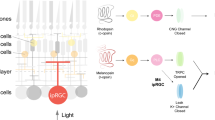Abstract
The purpose of this study was to examine inner-retinal contributions to the photopic sinusoidal flicker ERG. ERGs were recorded from 5 anesthetized monkeys to sinusoidally modulated (100%, 0.5–120 Hz) red full field flicker at Lmean of 3.2 log phot td on a rod saturating blue background (3.7 log scot td; 3.0 log phot td) before and after intravitreal injections of tetrodotoxin (TTX) to block Na+-dependent spikes of retinal ganglion and amacrine cells, followed by N-methyl-D-aspartate (NMDLA) to suppress all activity of these cells. Recordings also were made after blocking bipolar (and horizontal) cell responses with L-2-amino-4-phosphonobutyric acid (APB) and 2-cis-piperidine-2,3-dicarboxylic acid (PDA) or 6-cyano-nitroquinoxaline-2,3-dione (CNQX). Control fundamental (F1) and second harmonic (F2) amplitudes were large and variable at temporal frequencies up to 2 Hz. At higher frequencies, F1 amplitude was minimal with a phase step at a frequency between 13 and 19 Hz and maximal at 27–33 Hz. F2 was minimal at 2–3 Hz and maximal at 6–8 Hz, again with a phase step near the minimum. TTX, or NMDLA, produced small changes in F1 that shifted the amplitude minimum to a lower and the maximum to a higher frequency. In contrast, F2 was more strongly affected; both the amplitude minimum (and phase step) and maximum were greatly attenuated, leaving a moderate response from 0.5 to 8 Hz, which then declined as frequency was increased to 30 HZ. After APB and PDA or CNQX, F1 decreased continuously with increasing frequency and F2 was generally much smaller. The nearly linear F1 phase plot was consistent with the presence of a single mechanism (i.e. photoreceptors). Inner-retinal neurons contribute to the photopic sinusoidal flicker ERG. Whereas for F1, inner-retinal contributions are small relative to those from bipolar cells; for F2, they are equal or greater between 2 and 16 Hz.
Similar content being viewed by others
References
Bush RA, Sieving PA. Inner-retinal contributions to the primate photopic fast flicker electroretinogram. J. Opt. Soc. Am. A. 1996; 13: 557–65.
Kondo, M, Sieving PA. Primate Photopic Sine-Wave Flicker ERG: Vector Modeling Analysis of Component Origins Using Glutamate Analogs. Invest. Ophthalmol. Vis. Sci. 2001; 42: 305–12.
Baker CL, Hess RF, Olsen BT, Zrenner E. Current source density analysis of linear and non-linear components of the primate electroretinogram. J. Physiol. 1988; 407: 155–76.
Odom JV, Feghali JG, Jin JC, Weinstein GW. Visual function deficits in glaucoma: Electroretinogram pattern and illuminance nonlinearities. Arch. Ophthalmol. 1990; 108: 222–7.
Porciatti V, Falsini B. Inner retina contribution to the flicker electroretinogram: a comparison with the pattern electroretinogram. Clin. Vision Sci. 1993; 8: 435–47.
Hare W, Ton H, Woldemussie E, Ruiz G, Feldmann B, Wijono M. Electrophysiological and histological measures of retinal injury in chronic ocular hypertensive monkeys. Eur. J. Ophthalmol. 1999; 9(supp 1): S30–3.
Viswanathan S, Frishman LJ, Robson JG, Harwerth RS, Smith EL III. The photopic negative response of the macaque electroretinogram is reduced by experimental glaucoma. Invest. Ophtalmol. Vis. Sci. 1999; 40: 1124–36.
Viswanathan S, Frishman LJ, Robson JG. The uniform field and pattern ERG in macaques with experimental glaucoma: removal of spiking activity. Invest. Ophtalmol. Vis. Sci. 2000; 41: 277–2810.
Viswanathan S, Frishman LJ, Robson JG. Inner-retinal contributions to the photopic flicker electroretinogram of macaques. Optom. Vis. Sci., Suppl 2000; 77: 35.
Dawson WW, Trick GL, Litzkow CA. Improved electrode for electroretinography. Invest Ophthalmol. Vis. Sci. 1979; 18: 988–91.
Hess RF, Baker CL, Zrenner E, Schwarzer J. Differences between electroretinograms of cat and primate. J. Neurophysiol. 1986; 56: 747–68.
Bloomfield SA. Effect of spike blockade on the receptive-field size of amacrine and ganglion cells in the rabbit retina. J. Neurophysiol. 1996; 75: 1878–93.
Stafford DK, Dacey DM. Physiology of the A1 amacrine: A spiking, axon-bearing interneuron of the macaque monkey retina. Vis. Neurosci. 1997; 14: 507–22.
Gustincich S, Feigenspan A, Wu DK, Koopman LJ, Raviola E. Control of dopamine release in the retina: A transgenic approach to neural networks. Neuron 1997; 18: 723–36.
Robson JG, Frishman LJ. Response linearity and dynamics of the cat retina: The bipolar cell component of the dark-adapted ERG. Visual Neurosci. 1995; 12: 837–50.
Dong CJ, Hare WA. Contribution to the kinetics and amplitude of the electroretinogram b-wave by third-order retinal neurons in the rabbit retina. Vision Res. 2000; 40: 579–89.
Bush RA, Sieving PA. A proximal retinal component in the primate photopic ERG a-wave. Invest Ophthalmol. Vis. Sci. 1994; 35: 635–45.
Burns SA, Elsner AE, Kreitz MR. Analysis of nonlinearities in the flicker ERG. Optom. Vis. Sci. 1992; 69: 95–105.
Odom JV, Reits D, Burgers N, Riemslag FCC. Flicker electroretinogram: A systems analytic approach. Optom Vis. Sci. 1992; 69: 106–16.
Brown KT, Watanabe K. Isolation and identification of a receptor potential from the pure cone fovea of the monkey retina. Nature. 1962; 193: 958–60.
Whitten DN, Brown KT. The time courses of late receptor potentials from monkey cones and rods. Vision Res. 1973; 13: 107–35.
Heynen H, Van Norren D. Origin of the electroretinogram in the intact macaque eye: I. Principle component analysis. Vision Res. 1985; 25: 697–707.
Schnapf JL, Nunn BJ, Meister M, Baylor DA. Visual transduction in cones of the monkey Macaca fascicularis. J. Physiol. 1990; 427: 681–713.
Schneeweis DM, Schnapf JL. The photovoltage of macaque cone photoreceptors: Adaptation, noise, and kinetics. J. Neurosci. 1999; 19: 1203–16.
Marmor MF, Zrenner E. Standard for clinical electrophysiology (1999 update) 1999; 97: 143–56.
Author information
Authors and Affiliations
Rights and permissions
About this article
Cite this article
Viswanathan, S., Frishman, L.J. & Robson, J.G. Inner-retinal contributions to the photopic sinusoidal flicker electroretinogram of macaques. Doc Ophthalmol 105, 223–242 (2002). https://doi.org/10.1023/A:1020505104334
Issue Date:
DOI: https://doi.org/10.1023/A:1020505104334




